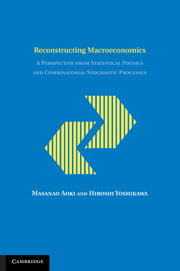 Reconstructing Macroeconomics
Reconstructing Macroeconomics Book contents
- Frontmatter
- Contents
- Preface by Masanao Aoki
- Preface by Hiroshi Yoshikawa
- 1 Introduction: A New Approach to Macroeconomics
- 2 The Methods: Jump Markov Process and Random Partitions
- 3 Equilibrium as Distribution: The Role of Demand in Macroeconomics
- 4 Uncertainty Trap: Policy Ineffectiveness and Long Stagnation of the Macroeconomy
- 5 Slow Dynamics of Macro System: No Mystery of Inflexible Prices
- 6 Business Cycles: An Endogenous Stochastic Approach
- 7 Labor Market: A New Look at the Natural Unemployment and Okun's Law
- 8 Demand Saturation-Creation and Economic Growth
- 9 The Types of Investors and Volatility in Financial Markets: Analyzing Clusters of Heterogeneous Agents
- 10 Stock Prices and the Real Economy: Power-Law versus Exponential Distributions
- References
- Author Index
- Subject Index
- Other books in the series (continued from page iii)
Preface by Hiroshi Yoshikawa
Published online by Cambridge University Press: 08 August 2009
- Frontmatter
- Contents
- Preface by Masanao Aoki
- Preface by Hiroshi Yoshikawa
- 1 Introduction: A New Approach to Macroeconomics
- 2 The Methods: Jump Markov Process and Random Partitions
- 3 Equilibrium as Distribution: The Role of Demand in Macroeconomics
- 4 Uncertainty Trap: Policy Ineffectiveness and Long Stagnation of the Macroeconomy
- 5 Slow Dynamics of Macro System: No Mystery of Inflexible Prices
- 6 Business Cycles: An Endogenous Stochastic Approach
- 7 Labor Market: A New Look at the Natural Unemployment and Okun's Law
- 8 Demand Saturation-Creation and Economic Growth
- 9 The Types of Investors and Volatility in Financial Markets: Analyzing Clusters of Heterogeneous Agents
- 10 Stock Prices and the Real Economy: Power-Law versus Exponential Distributions
- References
- Author Index
- Subject Index
- Other books in the series (continued from page iii)
Summary
Macroeconomics has gone astray. I suspect that many economists, or at least half of macroeconomists who are old enough to know the “Old Macroeconomics,” feel that way. In the past 30 years, macroeconomics has become less relevant.
The mainstream macroeconomics today begins with optimization of the representative consumer. The real business cycle (RBC) theory is the foremost example. The optimum growth theory once meant to be normative is now being taught as a descriptive theory. It is the neoclassical equilibrium theory. Preferences and technologies certainly move the economy. The prediction of the neoclassical doctrine seems often right for the very long run. However, saying that something moves eastward, and saying that it reaches the east end, are wholly different matters. Most of the time, the real economy must move on a bumpy road. It is misleading and wrong to analyze such problems as business cycles, unemployment, and deflation – the subject matters of macroeconomics – with the neoclassical equilibrium theory.
Contrary to the belief held by some economists, we need a new approach for macroeconomics, different from the standard equilibrium theory. The purpose of this book is to explain it. Having sound “microeconomic foundations for macroeconomics” has been long taken as building sophisticated optimization of an individual economic agent into a macro model. This agenda is on the wrong track. The new approach we advance in this book is based on the methods of statistical physics.
- Type
- Chapter
- Information
- Reconstructing MacroeconomicsA Perspective from Statistical Physics and Combinatorial Stochastic Processes, pp. xvii - xviiiPublisher: Cambridge University PressPrint publication year: 2006


